In the ever-evolving world of interior design, the open-concept living room kitchen is quickly becoming a sought-after trend among homeowners. This seamless integration of cooking and entertaining spaces not only enhances the functionality of a home but also creates a warm, inviting atmosphere that reflects the modern lifestyle. By breaking down the traditional barriers between the living room and kitchen, this innovative design approach offers a versatile and dynamic living experience that caters to the needs of families and avid entertainers alike.
Key Takeaways
- Open-concept living room kitchen designs blend cooking and entertaining spaces for a modern, functional home layout.
- This design trend promotes a more efficient and sociable way of living by creating a central hub for family gatherings and hosting guests.
- Homeowners can maximize the use of limited square footage and create a cohesive, visually appealing space through an open-concept layout.
- Carefully curated design elements, such as color palettes, materials, and lighting, help tie the living room and kitchen together for a seamless, harmonious look.
- Strategic furniture placement and zoning techniques can optimize the flow and functionality of an open-concept living room kitchen.
Embrace the Open-Concept Living Room Kitchen Trend
The open-concept living room kitchen design has become increasingly popular as homeowners seek to create more versatile and multifunctional spaces that cater to modern lifestyles. This design approach redefines traditional living and dining areas, offering a range of benefits that improve the overall functionality and appeal of the home.
Redefining Spaces for Modern Lifestyles
By removing walls and barriers, the open-concept layout merges the living room and kitchen into a seamless, cohesive space. This allows for a more flexible and efficient use of the available square footage, blending the family room, dining area, and entertaining space into a single, harmonious area.
Benefits of an Open Layout
The open-concept living room kitchen design brings several advantages to the table. It enhances natural light flow, creating a brighter and more inviting atmosphere. The improved spatial flow also facilitates better interaction and communication between family members and guests, fostering a sense of togetherness and community. Furthermore, the open floor plan offers greater flexibility when it comes to furniture layout and entertaining, making it easier to accommodate various gatherings and activities.
“The open-concept layout merges the living room and kitchen into a seamless, cohesive space, allowing for a more flexible and efficient use of the available square footage.”
As homeowners embrace the open-concept living room kitchen trend, they are redefining the way they interact with their living spaces, creating environments that better suit their modern lifestyles and entertaining needs.
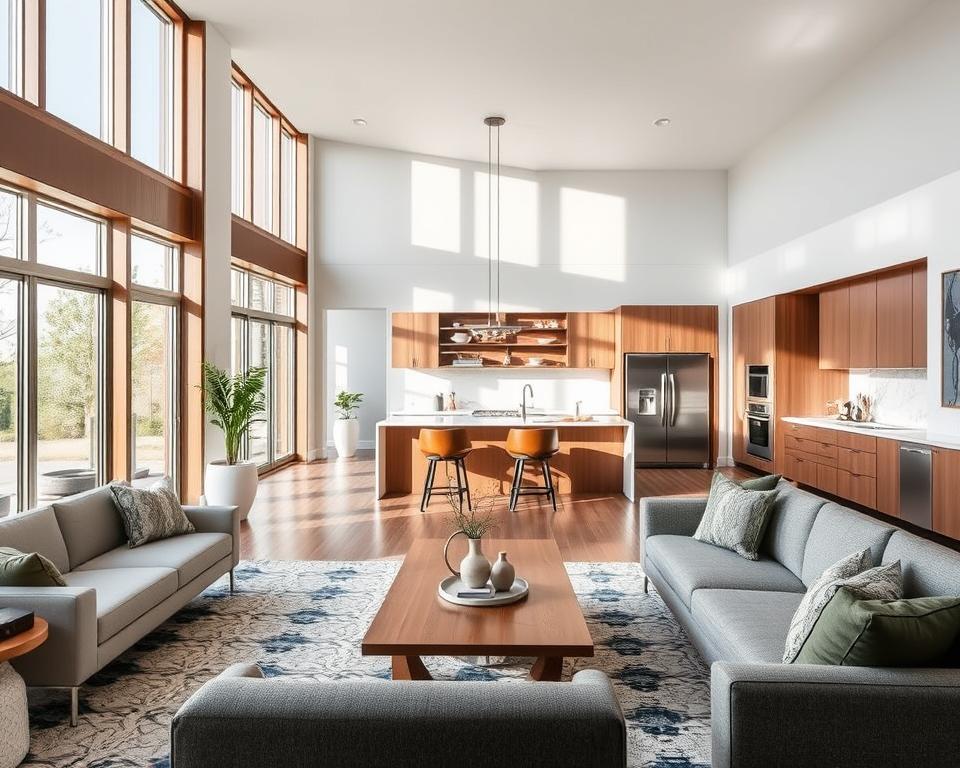
Seamless Flow: Connecting Living and Dining Areas
In an open-concept living room and kitchen, the seamless transition between the family room and dining area is crucial for creating a cohesive and visually appealing space. By carefully considering the furniture layout and color schemes, designers can achieve a harmonious flow that enhances the overall aesthetic and functionality of the open-plan layout.
One key strategy for connecting the living and dining zones is to select furniture that complements both areas. For instance, choosing a dining table that echoes the style of the living room seating can help unify the space. Additionally, incorporating a shared rug or using consistent color palettes throughout the open-concept area can visually tie the zones together.
Another important factor is the placement of the furniture. Arranging the pieces in a way that encourages movement and interaction between the living and dining areas can foster a sense of cohesion. This may involve positioning the sofa and chairs to face the dining table, or using a bench or stools that can serve both the living and dining spaces.
“The open-concept design trend has transformed the way we think about living and dining areas, allowing for a more fluid and dynamic use of space.”
By thoughtfully considering the furniture layout and color schemes, designers can create an open floor plan that seamlessly integrates the living and dining zones, fostering a sense of connection and flow throughout the entire open-concept space.

The Living Room Kitchen: A Multifunctional Hub
The open-concept living room kitchen serves as the heart of the modern home, seamlessly blending functionality and style. This multifunctional space is designed to accommodate a variety of daily activities, from meal preparation to socializing and relaxation.
By thoughtfully arranging the furniture layout and strategically placing lighting fixtures, this central hub can be transformed into an inviting entertaining space that caters to the needs of both the homeowner and their guests. The careful selection of color schemes and materials helps to create a cohesive and visually appealing environment, where the lines between the living room and kitchen are beautifully blurred.
Whether you’re hosting a dinner party or simply enjoying a quiet evening at home, the open-concept living room kitchen provides the perfect setting for a wide range of activities. By embracing the flexibility and versatility of this design, homeowners can create a space that truly reflects their modern lifestyle and personal style.

“The open-concept living room kitchen is the ultimate expression of the modern home’s desire for flexibility and sociability.”
Design Elements for a Cohesive Look
Crafting a visually captivating and harmonious open-concept living room kitchen requires a thoughtful approach to design elements. From the selection of color palettes and materials to the strategic placement of lighting fixtures, every detail plays a crucial role in achieving a cohesive and stylish environment that reflects the homeowner’s personal style.
Color Palettes and Materials
The choice of color scheme and materials can significantly impact the overall aesthetic of the open-concept living room kitchen. Opt for a color palette that seamlessly blends warm and cool tones, creating a sense of balance and visual interest. Incorporate a mix of natural materials, such as wood, stone, and textiles, to add depth and texture to the space.
- Utilize a neutral base with pops of vibrant, complementary colors to add visual appeal.
- Experiment with a combination of matte and glossy finishes to add visual depth.
- Incorporate natural elements like exposed beams or stone accent walls to bring warmth and character.
Lighting and Fixtures
Lighting plays a pivotal role in defining the ambiance and functionality of the open-concept living room kitchen. Strategically placed task lighting, such as pendant lights over the kitchen island or recessed lighting in the living area, can help delineate different zones while maintaining a cohesive flow.
| Lighting Type | Application | Benefits |
|---|---|---|
| Pendant Lights | Over Kitchen Island | Provides focused task lighting and adds visual interest |
| Recessed Lighting | Living Area | Creates a warm, ambient glow and enhances the overall lighting scheme |
| Floor Lamps | Sitting Area | Adds a cozy, decorative touch and can be used for task or accent lighting |
By carefully selecting and arranging the lighting fixtures, you can create a cohesive and functional open-concept living room kitchen that seamlessly blends form and function.
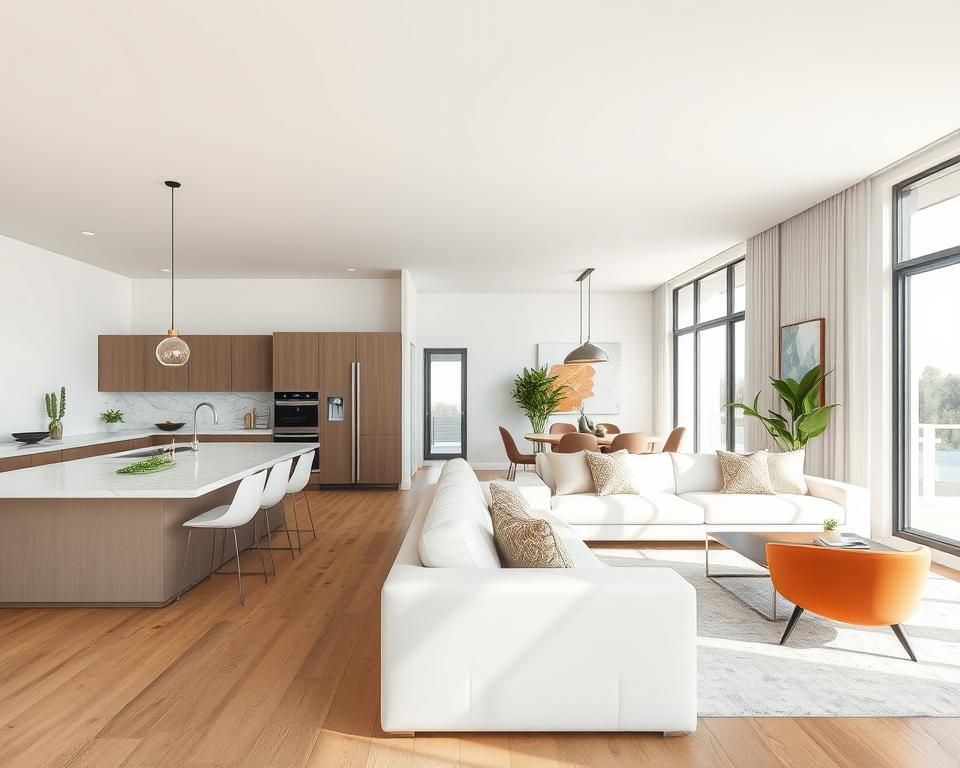
“The right lighting can transform a space, creating a warm and inviting atmosphere that enhances the overall design.”
Furniture Arrangement for Optimal Functionality
Arranging furniture in an open-concept living room kitchen requires a strategic approach to ensure optimal functionality and flow. By thoughtfully zoning the space, homeowners can maximize the use of the available area and create a visually cohesive and practical design.
Zoning Techniques
One effective zoning technique is to define distinct areas for dining, lounging, and food preparation. This approach helps to create a sense of purpose and order within the open layout, while still maintaining the overall openness and connectivity.
- Designate a dedicated dining area, complete with a table and chairs, to facilitate comfortable meal times and entertaining.
- Create a comfortable living space with plush seating arrangements, such as sofas and armchairs, to encourage relaxation and conversation.
- Establish a well-equipped kitchen zone with ample counter space and access to appliances, ensuring efficient food preparation.
By strategically placing furniture and defining these zones, homeowners can optimize the furniture layout and create a harmonious entertaining space that caters to both the family room and dining area needs.
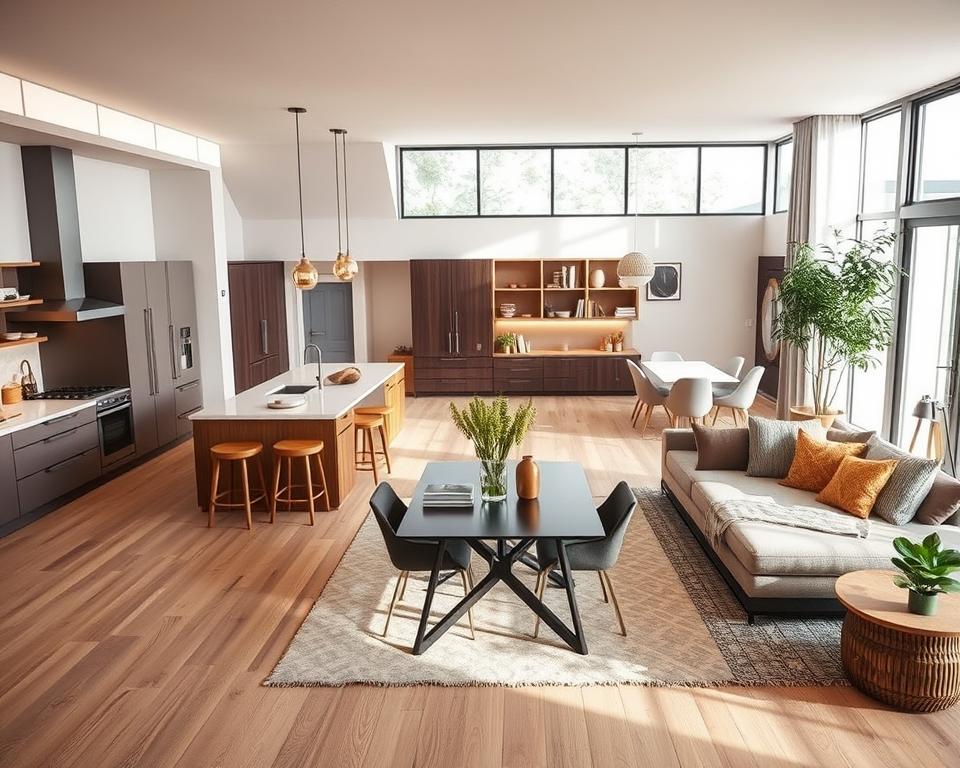
“Careful zoning and furniture placement can transform an open-concept living room kitchen into a highly functional and visually appealing space.”
Incorporating these zoning principles allows homeowners to create a seamless flow and maximize the potential of their open-concept living room kitchen, making it a versatile and inviting hub for both everyday living and special gatherings.
Maximizing Space in an Open-Concept Layout
Embracing the open-concept living room and kitchen trend can bring a sense of openness and versatility to your home. However, it can also present unique challenges when it comes to maximizing the available space. By implementing strategic design techniques and leveraging creative storage solutions, you can transform your open-concept layout into a harmonious and efficient living environment.
Zoning and Furniture Placement
One of the keys to maximizing space in an open-concept layout is effective zoning and furniture placement. Divide your open space into distinct areas, such as the family room, dining area, and kitchen, using subtle visual cues like furniture layout and lighting fixtures. Carefully arrange your furniture to define these zones and create a seamless flow between the different spaces.
- Utilize multi-functional pieces that can serve multiple purposes, such as a coffee table with built-in storage or a sofa with hidden compartments.
- Choose furniture with clean lines and a low profile to avoid visually cluttering the space.
- Incorporate lighting fixtures that can be adjusted to highlight specific areas and create a sense of depth and dimension.
By thoughtfully arranging your open floor plan, you can maintain the open and airy feel while ensuring each zone serves its intended function efficiently.
Storage and Organization
In an open-concept layout, storage and organization become crucial for maintaining a clutter-free and visually appealing space. Incorporate creative storage solutions that seamlessly blend with your overall design aesthetic.
- Utilize vertical space by installing shelves, cabinets, or built-in storage units along the walls.
- Opt for multi-purpose furniture, such as ottomans or benches with hidden storage compartments.
- Invest in smart organizational tools, like drawer dividers or modular storage systems, to keep your family room and dining area tidy and organized.
By strategically integrating storage solutions into your open-concept design, you can maintain a clean and uncluttered atmosphere while ensuring everything has a designated place.
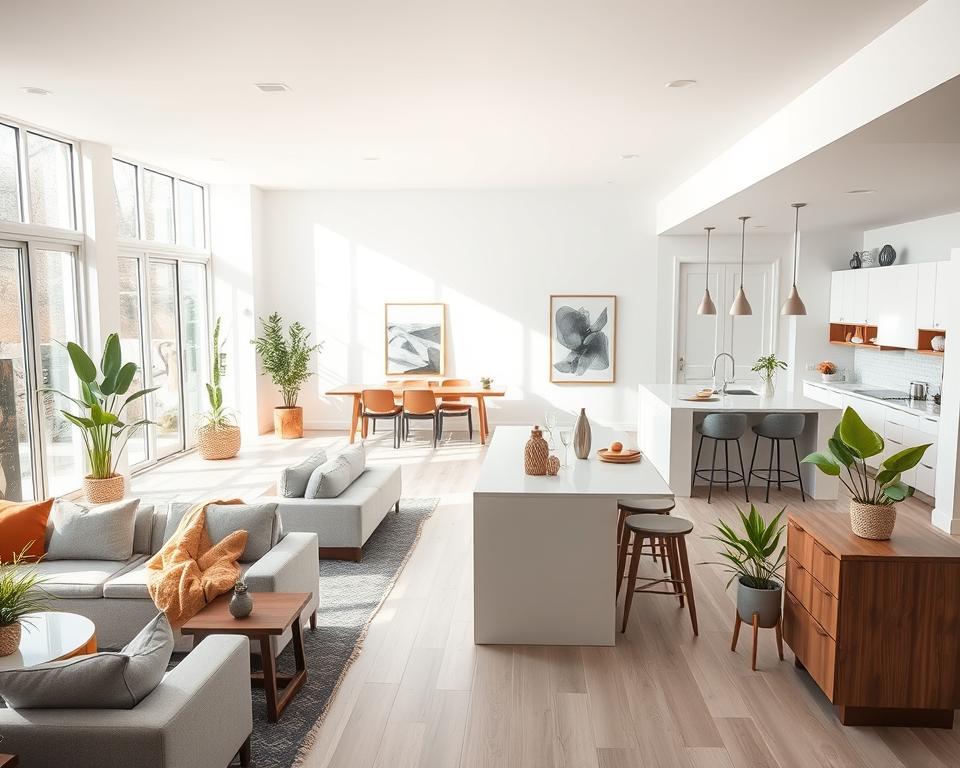
“Maximizing space in an open-concept layout is all about finding the right balance between functionality and aesthetics. With a little creativity and careful planning, you can transform your open-concept living room and kitchen into a harmonious and efficient living space.”
Striking a Balance: Privacy and Openness
The open-concept living room kitchen trend has revolutionized modern home design, offering a seamless flow and a multifunctional hub. However, some homeowners may desire a certain level of privacy within this open space. Clever partitioning solutions can help strike a balance between the benefits of an open floor plan and the need for personal space.
Partitioning Techniques for Privacy
Architectural elements such as half-walls, sliding doors, and strategically placed columns can create distinct zones while maintaining the overall open feel. Furniture arrangement can also be an effective tool, with the strategic placement of bookcases, room dividers, or area rugs defining the boundaries between the living and dining areas.
For a more flexible approach, movable screens or curtains can be used to easily partition off specific areas as needed, allowing for privacy when desired and an open layout when preferred. These partitioning solutions can be designed to complement the overall aesthetic, ensuring a cohesive and visually appealing space.
| Partitioning Technique | Benefit |
|---|---|
| Half-walls | Defines spaces while maintaining visual connection |
| Sliding doors | Provides privacy when closed, openness when open |
| Furniture arrangement | Delineates zones without permanent structures |
| Movable screens/curtains | Flexible partitioning for versatile living |
By incorporating these clever partitioning solutions, homeowners can enjoy the benefits of an open floor plan while also creating pockets of privacy within the family room and dining area. This balance of openness and personal space is key to designing a modern, functional, and comfortable open floor plan.
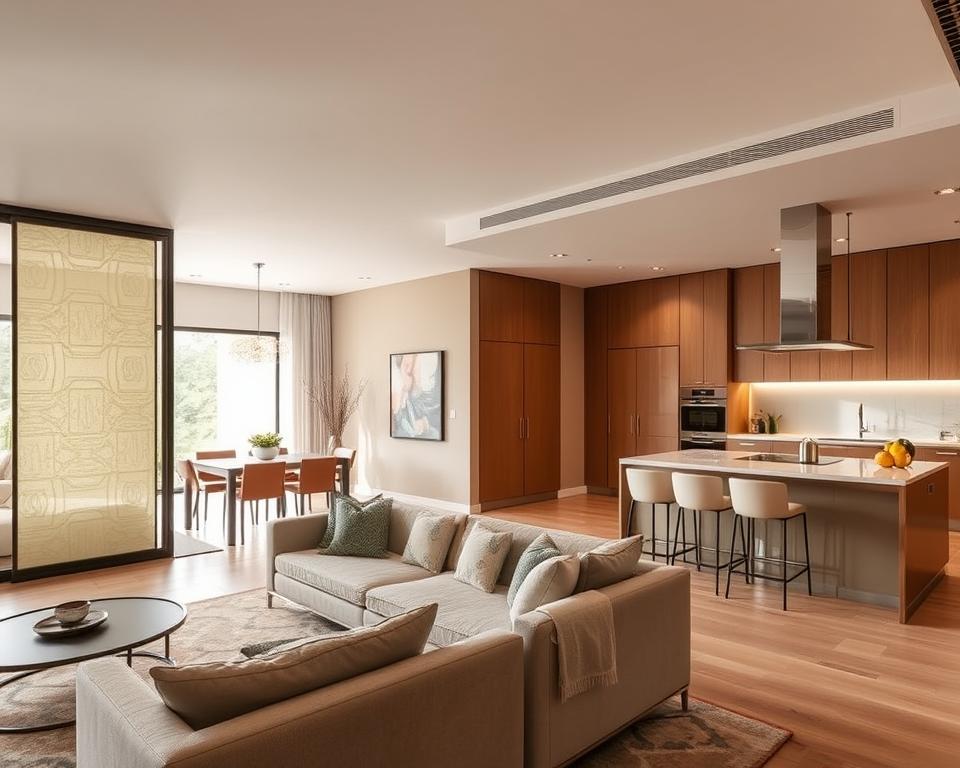
Open-Concept Living Room Kitchen: Entertaining Made Easy
The open-concept living room kitchen design is a versatile layout that seamlessly blends the entertaining space, family room, and dining area, creating a harmonious hub for gatherings. This inviting setup allows hosts to effortlessly transition between meal preparation, serving, and socializing, fostering a convivial atmosphere perfect for memorable celebrations.
When hosting events in an open-concept living room kitchen, consider the color schemes and lighting fixtures to set the desired ambiance. Soft, warm lighting can create a cozy, intimate vibe, while brighter, more dynamic illumination can energize the space for lively get-togethers. Experimenting with a variety of lighting options, such as pendant lights, recessed fixtures, and strategic placement of floor and table lamps, can help you achieve the perfect balance of illumination.
Arranging the furniture in a way that facilitates easy movement and conversation is key. Strategically placing seating areas, such as plush sofas and armchairs, around the perimeter of the open space can encourage guests to mingle and engage with one another. Additionally, incorporating a well-positioned dining area where guests can gather for meals or hors d’oeuvres further enhances the entertaining capabilities of the open-concept layout.
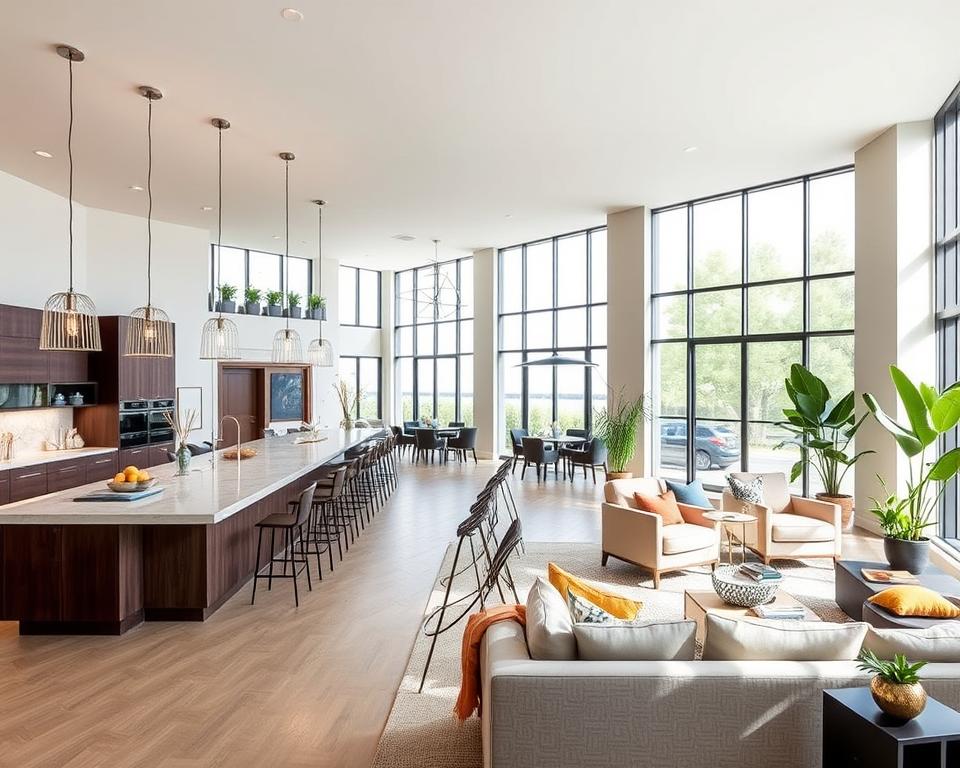
By embracing the open-concept living room kitchen design, you can create a welcoming and versatile space that caters to your entertaining needs. Whether hosting intimate gatherings or large-scale celebrations, this layout offers the perfect balance of functionality and style, allowing you to effortlessly entertain your guests in a seamless and visually appealing environment.
Incorporating Personal Touches and Style
Infusing an open-concept living room kitchen with personal touches and unique style is the key to creating a space that truly reflects the homeowner’s individuality. By incorporating carefully selected home decor elements, interior design accents, and customized furniture layout and lighting fixtures, you can transform this multifunctional hub into a sanctuary that exudes your distinct color schemes and personality.
Start by curating a collection of artwork, photographs, and decorative pieces that hold special meaning for you. Strategically placing these items throughout the open layout can add depth, character, and a sense of personal narrative to the space. Complementing these personal touches with thoughtfully chosen furniture and lighting solutions will further enhance the cohesive and harmonious feel of the room.
Ultimately, the open-concept living room kitchen is a canvas waiting to be filled with your unique interior design vision. By seamlessly blending functional necessities with carefully crafted home decor elements, you can create a space that not only serves your practical needs but also reflects your distinct style and aesthetic preferences.
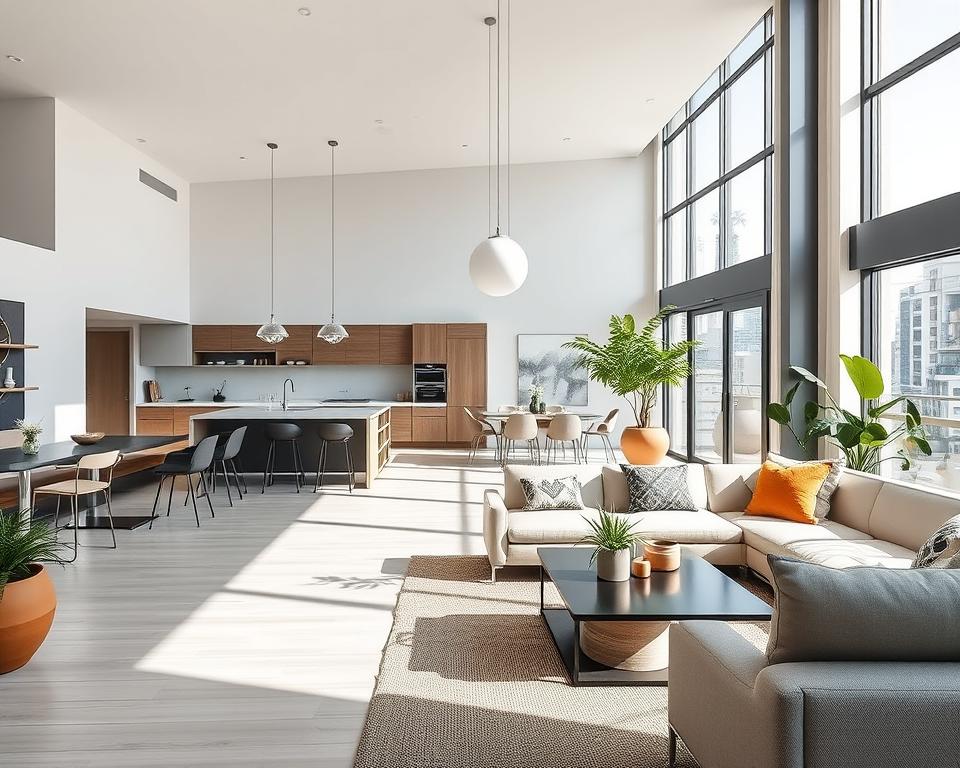
Leave a Reply